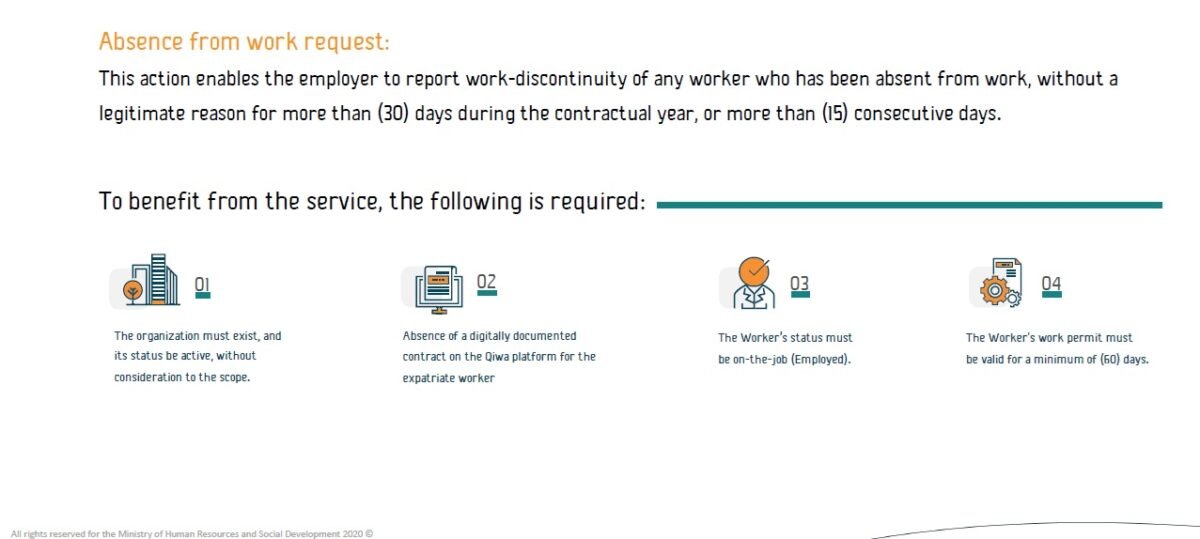How to Report a Huroob (Absent-from-Work) Employee in Saudi Arabia: A Practical Guide for Employers
Companies in Saudi Arabia may need to report a worker as “Absent from Work” (known colloquially as huroob) when the worker stops attending duties without a legitimate reason. To make this process consistent and fair, the Ministry of Human Resources and Social Development (MHRSD) provides a standard, electronic pathway—primarily via the Qiwa platform. This article consolidates the official steps, required conditions, and likely outcomes, all sourced from the official MHRSD procedural guide and related primary references.
Legal basis for reporting Huroob absence from work
Saudi Labor Law allows termination if a worker is absent without valid reason for more than 30 days in one contractual year or more than 15 consecutive days, provided the employer has issued the required written warnings (after 20 days in the first case and 10 days in the second).
MHRSD’s own knowledge articles mirror this threshold, reaffirming that unjustified absence beyond 30 (intermittent) or 15 (consecutive) days can justify ending the contract—subject to due warning requirements
What the “Absent from Work” (huroob) service does
Through Qiwa, an employer can file an “Absence from work” request to report a worker’s discontinuity from work when the thresholds above are met. Once submitted and accepted, the worker’s status changes to “Absent from Work” across Ministry systems and is removed from the establishment’s records (including Nitaqat counts). The worker is then given a grace period to either transfer to a new employer or issue a final exit.
MHRSD has also clarified in official updates that a 60-day window applies for workers to transfer or terminate employment before the system reflects “Absent from Work,” and/or after an absence report is active to regularize status—part of ongoing reforms to stabilize contractual relationships.

Pre-filing conditions you must meet to report huroob
 How to Report a Huroob (Absent-from-Work) Employee in Saudi Arabia: A Practical Guide for Employers[/caption]
How to Report a Huroob (Absent-from-Work) Employee in Saudi Arabia: A Practical Guide for Employers[/caption]
Before you submit an absence report in Qiwa, ensure the following preconditions:
Active establishment: Your organization must exist and its status must be active.
Worker status = Employed: The worker must be currently on-the-job (not already terminated or transferred).
No digitally documented contract in Qiwa: The absence service in this guide applies to workers without a digitally documented work contract in Qiwa.
Iqama/work permit validity: The worker’s work permit (Iqama) must have at least 60 days remaining at the time of filing the absence request.
Step-by-step: Filing an absence (huroob) report in Qiwa
Sign in to Qiwa (Business Owner account). Navigate to Services → Contract Management → Absent employees, then click “Absent laborer request.” qiwa.sa
Select the employee you wish to report and enter the reason for termination on the “absence from work” grounds (i.e., exceeded 30 intermittent or 15 consecutive days without legitimate reason).
Acknowledge the consequence notice (non-retractable removal of worker’s record from your establishment; worker will be able to transfer or request final exit within the prescribed period). Confirm and submit the request. (See the consent text in Figure 2.)
System notifications are sent by SMS to both parties. The worker’s file is removed from your establishment, and their status becomes “Absent from Work.” They are no longer counted in your Nitaqat calculation. (See Figure 2.)
Post-submission window: The worker has up to 60 days to transfer to a new employer (if eligible) or to issue a final exit. (See Figure 3 for the scenario outcomes.)
What happens after you file huroob
Per the official guide, one of three outcomes typically occurs (Figure 3):
Worker transfers to new employer (within the grace period).
The new employer initiates a transfer request; the worker approves; MHRSD approves; and the change is completed across systems.Worker issues a final exit (within the grace period).
The worker can issue a final exit visa from their Absher account if they meet eligibility criteria. (Absher’s official guides explain final-exit issuance steps.)No action taken within the window (violation).
If the worker neither transfers nor exits within the allowed timeline, the system retains “Absent from Work” status and reflects this across associated systems.
MHRSD’s 60-day windows and adjustments have been reiterated in official news and updates to promote orderly transitions and protect contractual rights.
Special case: “Existing Requests” filed before the initiative
If the worker had an active absence report filed before the new initiative’s launch,
- The worker’s status must be “Absent from Work,” and the report date must predate the initiative’s launch.
- A new employer may submit a transfer request (maximum two attempts allowed).
- The new employer acknowledges and pays any late fees, and the report is uplifted in related government systems during transfer.
- If not completed within 15 days or rejected by the National Information Center, the absence report is re-uploaded and the transfer request is cancelled.
- Upon completion, Qiwa reflects the transfer in the new employer’s records, and the employer is duly notified.
If a worker is transferring after being reported absent Nakal Kafala after huroob
The prospective employer initiates the Worker Transfer in Qiwa and enters the worker’s ID;
The pledge to pay late fees (if any) is acknowledged;
The worker logs into Qiwa and approves the transfer to the new employer;
The absence report is handled across related government systems;
After successful responses from those systems, the transfer completes and appears in the new employer’s records;
The new employer is notified of completion.
Practical huroob compliance pointers for employers
- Document warnings: If termination may follow, ensure written warnings were issued in line with the Labor Law (after 20 days intermittent absence or 10 days consecutive absence). Keep dated copies for your records.
- Check eligibility before you file: Confirm the establishment is active, the worker is currently employed, Iqama validity ≥ 60 days, and that there is no Qiwa-documented contract if you’re relying on the exact pathway in the guide.
- Use the correct Qiwa path: In Qiwa, the “Absent laborer request” is accessed under Contract Management for current employees. qiwa.sa
- Know what filing triggers: Filing an absence report removes the worker’s record from your establishment and excludes them from Nitaqat counts, with SMS notifications to both sides.
- Be aware of windows and updates: The 60-day window for transfer or final exit is a key safeguard to ensure proper regularization of status and is reflected in recent MHRSD/Qiwa communications.
- Final exit logistics: Workers who qualify can apply for a final exit through Absher (individual pathways vary)
Huroob Frequently asked employer questions
1) Do I need to warn the employee before I file an absence report?
If you are moving toward termination, the Labor Law requires written warnings at specified thresholds (20 days intermittent, 10 days consecutive). Keep proof.
2) Will the worker still count in my Nitaqat after I file?
No. Once an absence report is processed, the worker’s record is removed from your establishment and not counted in Nitaqat.
3) Can the worker leave the Kingdom on a final exit instead of transferring?
Yes—within the grace period, eligible workers may issue a final exit via Absher.
4) What if the worker had been reported absent before the new initiative?
Follow the “Existing Request” mechanism (limited attempts, late-fee pledges, and 15-day completion window)
5) Has MHRSD/Qiwa changed anything recently about absence reporting?
Yes—official updates emphasize a 60-day window associated with interruption/absence handling to protect both parties and allow transfer/exit regularization.
Bottom line
Reporting “Absent from Work” is not merely a button click; it rests on clear statutory thresholds, documented warnings, and precise electronic steps in Qiwa. The official MHRSD procedural guide and the Labor Law are your primary anchors—use them to ensure your report is valid, your records are complete, and any follow-on processes (transfer or final exit) are handled correctly and on time.
Disclaimer :
The information provided in blog articles and how-to guides on the LinkArabia website is for general informational purposes only. While we strive to provide accurate and up-to-date content, we make no representations or warranties of any kind, express or implied, about the completeness, accuracy, reliability, suitability, or availability of the information. Any reliance you place on such information is strictly at your own risk. For more information , please read linkarabia disclaimer policy.




